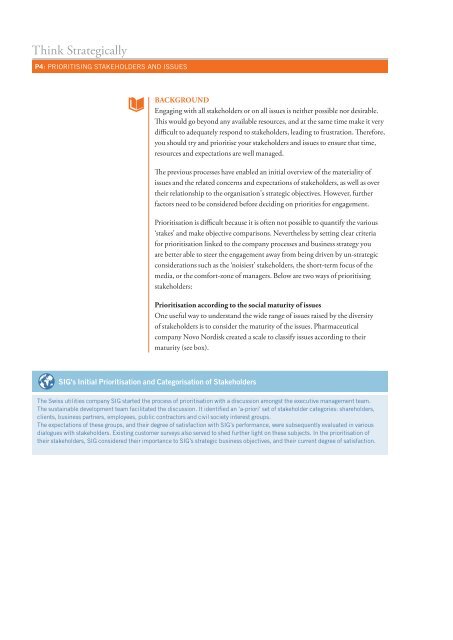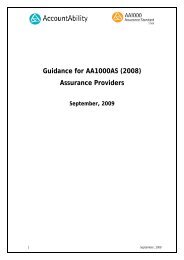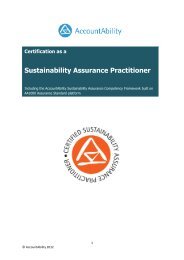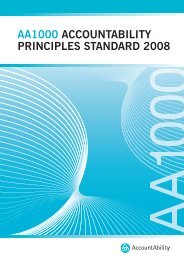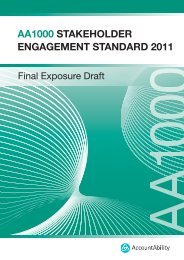The Stakeholder Engagement Manual Volume 2 - AccountAbility
The Stakeholder Engagement Manual Volume 2 - AccountAbility
The Stakeholder Engagement Manual Volume 2 - AccountAbility
You also want an ePaper? Increase the reach of your titles
YUMPU automatically turns print PDFs into web optimized ePapers that Google loves.
Think Strategically<br />
P4: PRIORITISING STAKEHOLDERS AND ISSUES<br />
BACKGROUND<br />
Engaging with all stakeholders or on all issues is neither possible nor desirable.<br />
Th is would go beyond any available resources, and at the same time make it very<br />
diffi cult to adequately respond to stakeholders, leading to frustration. Th erefore,<br />
you should try and prioritise your stakeholders and issues to ensure that time,<br />
resources and expectations are well managed.<br />
Th e previous processes have enabled an initial overview of the materiality of<br />
issues and the related concerns and expectations of stakeholders, as well as over<br />
their relationship to the organisation's strategic objectives. However, further<br />
factors need to be considered before deciding on priorities for engagement.<br />
Prioritisation is diffi cult because it is often not possible to quantify the various<br />
‘stakes’ and make objective comparisons. Nevertheless by setting clear criteria<br />
for prioritisation linked to the company processes and business strategy you<br />
are better able to steer the engagement away from being driven by un-strategic<br />
considerations such as the ‘noisiest’ stakeholders, the short-term focus of the<br />
media, or the comfort-zone of managers. Below are two ways of prioritising<br />
stakeholders:<br />
Prioritisation according to the social maturity of issues<br />
One useful way to understand the wide range of issues raised by the diversity<br />
of stakeholders is to consider the maturity of the issues. Pharmaceutical<br />
company Novo Nordisk created a scale to classify issues according to their<br />
maturity (see box).<br />
SIG's Initial Prioritisation and Categorisation of <strong>Stakeholder</strong>s<br />
<strong>The</strong> Swiss utilities company SIG started the process of prioritisation with a discussion amongst the executive management team.<br />
<strong>The</strong> sustainable development team facilitated the discussion. It identifi ed an ‘a-priori’ set of stakeholder categories: shareholders,<br />
clients, business partners, employees, public contractors and civil society interest groups.<br />
<strong>The</strong> expectations of these groups, and their degree of satisfaction with SIG’s performance, were subsequently evaluated in various<br />
dialogues with stakeholders. Existing customer surveys also served to shed further light on these subjects. In the prioritisation of<br />
their stakeholders, SIG considered their importance to SIG’s strategic business objectives, and their current degree of satisfaction.


